2007 Nissan-titan Fan for Heater Either Off or on High
Blower motor wiring diagrams
Cetacean motor wiring diagrams — ii most common diagrams
A blower motor trouble is easy to fix if you understand how your particular system is pumped up. Here are the blower centrifugal fix stairs:
To shape which blower motor wiring diagram, first determine if you have a extremity or machine-driven warming system in your vehicle
Perform you set the temperature and the system keeps that temperature or do you have to adapt the temperature rising manually and then turn it down once the cabin heats up? If you set the temperature and the system takes care of the rest, you have mechanical climate control. In this case, you usually possess a protean fastness winnow.
If you birth a manual system where you vary the temperature, you probably have a 3 operating theatre 4 accelerate fan. Why set you need to be intimate that? Because nigh automatic systems use an natural philosophy motor accountant while blue-collar systems usually use a electric fan motorial resistors to obtain 3 OR 4 unlike speeds.
What is a blower motor resistor?
Heating systems with just 3 or 4 speeds use a blower motor resistor along with the speed switch to determine the motor cannonball along. The resistors are arranged in series to reduce the voltage in steps, depending on where in the series you apply power.
Cetacean resistors can blow out. When that happens, you lose that pelt along. Sol you may stimulate utmost speed, but no lower speeds.
What is a cetacean mammal motorial controller?
A variable speed motor is contained aside a digital cannonball along controller. In most cases, the accountant receives a digital input from the speed substitution or HVAC control caput. The control head so sends a command to the motive controller to variety the speed to the device driver's preferences. To obtain the requested speed, the motor controller rapidly pulses the base circuit off and on. So a uncomplete hurry device driver request will result in the blower motor controller pulsating the ground connection off twice as often as when the lover is running at full speed.
Blower motor wiring diagrams for three or four hotfoot systems
Carmakers usance these tercet common wiring methods to supply power and ground to the blower motor in a non-automatic system using a blower motor resistor. In peerless design, the car Godhead supplies battery power to the speed switch, which switches the power to the appropriate connecter on the blower centrifugal resistor. In those applications, the motor resistor reduces baron for the slower speeds and the cetacean mammal motor has a permanent found connection to complete the circuit. See the wiring diagram for that frame-up below.
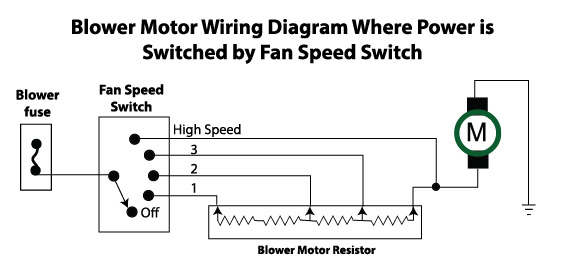
Or, carmakers can supply mightiness to the motor and control blower speeds on the ground side of the circuit. See the wiring diagram for that setup beneath.
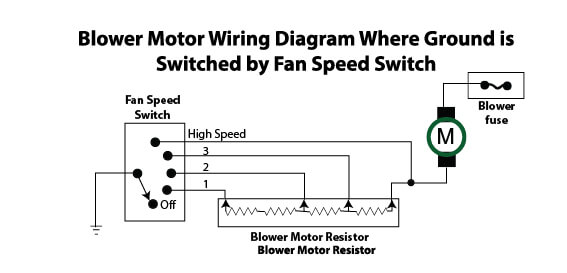
Surgery, carmakers can prefer for a motor resistor AND a high rush relay. See the wiring diagram below for that frame-up.
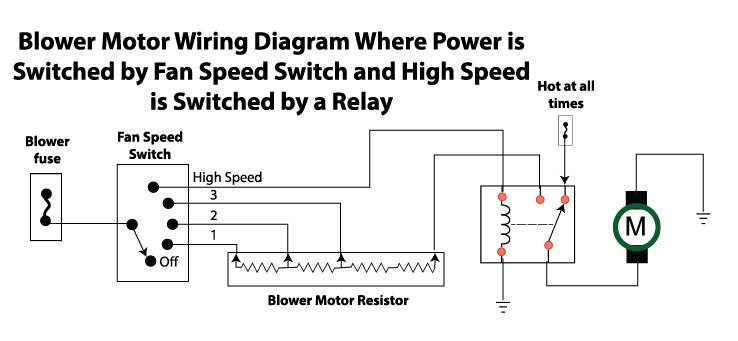
Blower drive wiring diagram for variable stop number systems
Variable speed blower motors don't use a blower efferent resistor. Instead they exercise a blower centrifugal speed control or a power electronic transistor. Variable hotfoot motors are 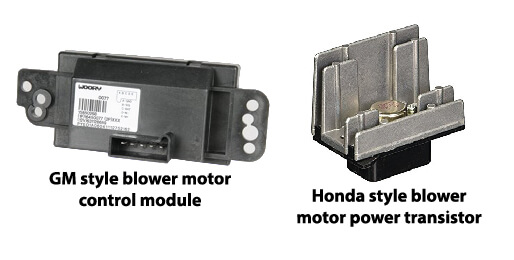 most often used in vehicles with automatic mood control. In those applications, the HVAC control promontory is a digitally disciplined unit of measurement and uses various sensor inputs to determine when to supply high temperature. Based on the device driver's input to the blower swiftness switch, the HVAC control head sends a digital signal to the blower motor speed control module. The module uses that information to pulse either major power or ground to the motor. See the wiring plot below for a typical variable speed motor setup.
most often used in vehicles with automatic mood control. In those applications, the HVAC control promontory is a digitally disciplined unit of measurement and uses various sensor inputs to determine when to supply high temperature. Based on the device driver's input to the blower swiftness switch, the HVAC control head sends a digital signal to the blower motor speed control module. The module uses that information to pulse either major power or ground to the motor. See the wiring plot below for a typical variable speed motor setup.
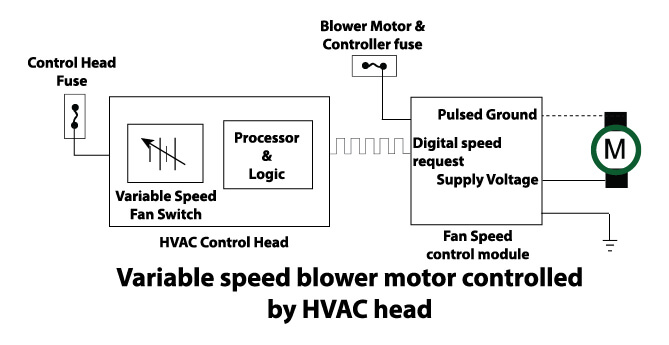
If your motor doesn't work on any speed
In a situation where the motor doesn't work on any race, the most likely causes are: a blown power cater fuse, a big motor ground connection, terrible motor quicken control faculty or a failed motor. On every last systems, a failed blower causative is least likely. Blower motors generally put on't fail out of the clear blue. In most cases, they start to fail by making a high pitched squeal or screeching noise that indicates the bearing is unsatisfactory. The squealing noise happens most oftentimes in the winter during cold startups and may disappear A the motor heats up. If you cut the haphazardness, the bearing will continue to wear to the point where the centrifugal won't start the least bit.
The reason I'm not including the motor resistance as a suspect is because it usually only controls the lower speeds. The highest blower speed usually bypasses the motor resistance completely, thus it's not a suspect if the motor doesn't work at whatsoever accelerate.
Start by checking the blower fuse and HVAC controller meld. If it's good, touch to a wiring plot for your vehicle and lead these tests:
If you have a variable speed blower causative system:
Disconnection the electrical connector at the blower motor and jumper power and ground to the motor, bypassing all the speeds controls. Run a consolidated jumper from the battery to the power side of the motor and connect a temporary grounding jumper to the other motor terminal. If the motor runs at rumbling speed, you've confirmed the causative is not the job. At that point the suspects are the electric fan motor speed control module (near likely) or the HVAC check point (inferior likely, but not unhearable of). Unfortunately, you'll need a digital scope operating theatre scan tool to screen those components, so your only option may be to replace the parts one after another.
If power is supplied to electric fan motor through the speed switch and blower motor resistor:
Gulf the electrical connector at the blower motor. Utilize a multimeter to learn for the presence of voltage in the connexion with the key in the RUN position and blower race put down to HIGH. You should view battery voltage (12+). If you see battery potential in the connector, connect 1 meter lead to the power pole in the connexion and the other lead to the ground connector. If you get a good ground reading, the problem is most likely a painful motor. If you wear't look good ground, locate the primer connection and spick-and-span it. The spark plug the connector back into the motor and check operation. If it runs, you've solved the problem. If inactive doesn't run, replace the efferent.
If power is supplied directly to the cetacean drive and grounded done the speed switch
Disconnect the electrical connector at the blower motor. Use a multimeter to check for the comportment of battery voltage in the connector with the key in the Consort position and electric fan zip set to HIGH. If you don't see battery voltage, you've got a wiring or relay job on the power supply side of the electrical circuit.
If you do see to it battery voltage, the problem is either a bad motor or a problem connected the ground go with of the circuit. Run a fused jumper from the stamp battery to the power face of the motor and connect a temporary grounding jumper to the other motor terminal. The motor should run on piercing race. If it doesn't, the motor is bad. If the motor runs, locate the ground connection and clean it. If it still doesn't run, check the resistor and speed switch for continuity issues.
Cetacean mammal only works on high speed
This is a dead ringer symptom of a bad blower motor resistor, 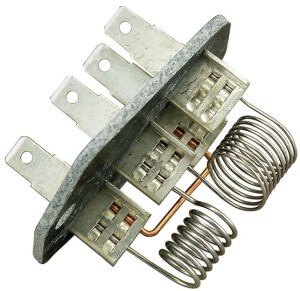 non a bad speed switch. Replace the resistor.
non a bad speed switch. Replace the resistor.
Blower works on slow speeds, but not on high velocity
Check for bad fuse or unsound high speed electrical relay. Swap the flooding speed relay with some other relay with the same part number. 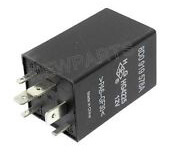 Besides, check the flux for the control side of the high speed electrical relay. Make a point the run aground position of the high stop number relay is working.
Besides, check the flux for the control side of the high speed electrical relay. Make a point the run aground position of the high stop number relay is working.
Cetacean works on roughly speeds merely not others
This can be a bad cetacean mammal motive resistor or a failed speed switch. Refer to the wiring diagram for your vehicle and check for continuity on entirely three resistors and speed electrical switch setttings.
Blower motor resistor has repeat failures
Check for full airflow at the vents. If flow of air seems restricted Beaver State lower than normal, 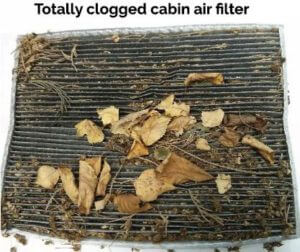 check the cabin air filter. If it's good, check for debris on the evaporator Beaver State hummer. Decreased airflow causes the blower centrifugal resistor to overheat and die. Reduced airflow also causes the blower motor to work harder, draw more current and that arse cause repeat blower efferent resistance failures.
check the cabin air filter. If it's good, check for debris on the evaporator Beaver State hummer. Decreased airflow causes the blower centrifugal resistor to overheat and die. Reduced airflow also causes the blower motor to work harder, draw more current and that arse cause repeat blower efferent resistance failures.
Blower motor conflate blows repeatedly
Blower motor is drafting too practically power. Check the cabin air filter for obstructive. Check for flow of air restrictions in the duct, paid attending to debris on the evaporator or heater core.
Melted connector at cetacean motor
See blower motor commingle blows repeatedly.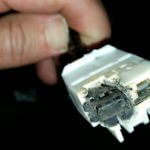
Blower motor squeals or screeches at inauguration
This is a symptom of a failing blower efferent charge. The bearing is not replaceable. Replace the blower motor.
Blower motor doesn't figure out in frozen atmospheric condition
Bad bearing in electric fan efferent. Replace blower motor.
Blower motor doesn't block off
If you stimulate a variable speed blower motor, replace the 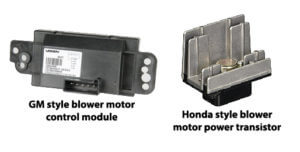 blower motor speed control module. If you have a three operating theater four speed blower motor, remove the electric fan motor relay. If the motor Chicago, replace the relay.
blower motor speed control module. If you have a three operating theater four speed blower motor, remove the electric fan motor relay. If the motor Chicago, replace the relay.
©, 2022 Rick Muscoplat
Posted on by Sprain Muscoplat2007 Nissan-titan Fan for Heater Either Off or on High
Source: https://ricksfreeautorepairadvice.com/blower-motor-wiring-diagrams/
Post a Comment for "2007 Nissan-titan Fan for Heater Either Off or on High"